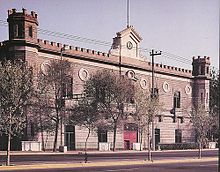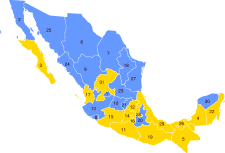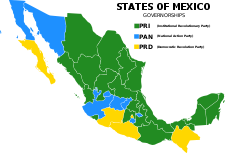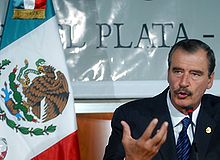- Politics of Mexico
-
Mexico 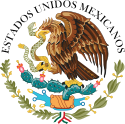
This article is part of the series:
Politics and government of
MexicoExecutiveGeneral
Other countries · Atlas
Mexico Portal
The politics of Mexico take place in a framework of a federal presidential representative democratic republic whose government is based on a congressional system, whereby the president of Mexico is both head of state and head of government, and of a multi-party system. The federal government represents the United Mexican States and is divided into three branches: executive, legislative and judicial, as established by the Political Constitution of the United Mexican States, published in 1917. The constituent states of the federation must also have a republican form of government based on a congressional system as established by their respective constitutions.
The executive power is exercised by the executive branch, which is headed by the President, advised by a cabinet of secretaries that are independent of the legislature. Legislative power is vested upon the Congress of the Union, a two-chamber legislature comprising the Senate and the Chamber of Deputies. Judicial power is exercised by the judiciary, consisting of the Supreme Court of Justice of the Nation, the Council of the Federal Judiciary and the collegiate, unitary and district tribunals.
The politics of Mexico are dominated by three political parties: National Action Party (PAN), the Party of the Democratic Revolution (PRD) and Institutional Revolutionary Party (PRI).
Contents
Political parties
Constitutionally, political parties in Mexico must promote the participation of the people in the democratic life of the country, contribute in the representation of the nation and citizens, and be the access through which citizens can participate in public office, through whatever programs, principles and ideals they postulate.[1] All political parties must be registered before the Federal Electoral Institute (IFE), the institution in charge of organizing and overseeing the federal electoral processes, but must obtain at least 2% of votes in the federal elections to keep their registry. Registered political parties receive public funding for their operation and can also obtain private funding within the limits prescribed by the law. As of 2010 the following political parties are registered before the IFE and all have representatives at the Congress of the Union:
- Institutional Revolutionary Party (Partido Revolucionario Institucional, PRI), founded in 1929;
- National Action Party (Partido Acción Nacional, PAN), founded in 1939;
- Party of the Democratic Revolution (Partido de la Revolución Democrática, PRD), founded in 1989;
- Labor Party (Partido del Trabajo, PT), founded in 1990;
- Green Ecological Party (Partido Verde Ecologista de México, PVEM), founded in 1986, but lost its registry on two consecutive elections; it has retained its registry since 1993;
- Convergence Party (Convergencia), founded in 1997;
- New Alliance (Nueva Alianza, PNA or PANAL), founded in 2005;
Political parties are allowed to form alliances or coalitions to nominate candidates for any particular election. The coalition must present itself with a particular name and logo. Proportional representation (plurinominal) seats are assigned to the coalition based on the percentage of votes obtained in the elections, and then the coalition re-assigns them to the constituent political parties. Once each party in the coalition has been assigned plurinominal seats, they do not necessarily continue to work as a coalition in government.
Throughout the 20th century, PRI had an almost hegemonic power at the state and federal level, which slowly began to recede in the late 1980s. Even though since the 1940s, PAN had won a couple of seats in the Congress, and in 1947 the first presidential municipality (in Quiroga, Michoacán),[2] it wasn't until 1989, that the first non-PRI governor of a state was elected (at Baja California). It was in 1997, that PRI lost its absolute majority at the Congress of the Union, and in 2000 the first non-PRI president was elected since 1929.
Elections and political composition of the institutions
Suffrage is universal, free, secret and direct for all Mexican citizens 18 and older, and is compulsory (but not enforced). The identity document in Mexico serves also as the voting card, so all citizens are automatically registered for all elections; that is, no pre-registration is necessary for every election. All elections are direct; that is, no electoral college is constituted for any of the elections at the federal, state or municipal level. Only when an incumbent president is absolutely absent (either through resignation, impeachment or death), the Congress of the Union constitutes itself acts as an electoral college to elect an interim president by absolute majority.
Presidential elections are scheduled every six years, except in the exceptional case of absolute absence of the president. Legislative elections are scheduled every six years for the Senate, to be fully renewed in elections held concurrently with the presidential elections; and every three years for the Chamber of Deputies. Elections are usually held on the first Sunday of July. State governors are also elected every six years, whereas the legislatures are renewed every three years. State elections need not be concurrent with federal elections. Federal elections are organized and supervised by the autonomous public Federal Electoral Institute, whereas state and municipal elections are organized and supervised by electoral institutes constituted by each state of the federation. Elections within the Federal District are also organized by a local electoral institute.
A strongly ingrained concept in Mexican political life is "no reelection." The theory was implemented after Porfirio Díaz managed to monopolize the presidency for over 25 years. Presently, Mexican presidents are limited to a single six-year term, and no one who has held the office even on a caretaker basis is allowed to hold the office again. Deputies and senators are not allowed to immediately succeed themselves.
Federal elections
The most recent federal presidential elections were held on July 2, 2006 concurrent with the full renovation of both chambers of the Congress of the Union. In these elections the Party of the Democratic Revolution (PRD), the Labour Party (PT) and Convergence (CV) formed a coalition called Coalition for the Good of All. The Institutional Revolutionary Party (PRI) and the Ecologist Green Party (PVEM) formed a coalition called Alliance for Mexico.
Presidential elections
The presidential elections were the most competitive in the history of the country in which the difference in the ballot count between the winner and the first runner up was less than one percent point, and in which neither candidate got absolute majority in a system in which a second round of voting has not been instituted. Felipe Calderón got the greatest number of votes according to the preliminary computation (PREP) and the ballot recount. Andrés Manuel López Obrador contested the results and demanded a vote-per-vote recount, which was denied by the Federal Electoral Tribunal, based on the argument that inconsistencies could not be proved for all electoral circumscriptions, but order a partial recount of votes of those that did show inconsistencies which represented 9.2% of the total, after which the results were not significantly altered. The Federal Electoral Tribunal declared Felipe Calderón the winner of the elections on September 5, and president elect. He took office on December 1, and his term will end on November 30, 2012.
Summary of the 2 July 2006 Mexican presidential election results Candidates Party Votes % Felipe Calderón National Action Party 15,000,284 35.89% Andrés Manuel López Obrador Coalition for the Good of All (PRD, PT, CV) 14,756,350 35.31% Roberto Madrazo Alliance for Mexico (PRI, PVEM) 9,301,441 22.26% Patricia Mercado Social Democratic and Peasant Alternative Party 1,128,850 2.70% Roberto Campa Cifrián New Alliance 401,804 0.96% Write in 297,989 0.71% Blank/Invalid 904,604 2.16% Total 41,791,322 100.0% Source: Instituto Federal Electoral [1] Congressional elections
The concurrent congressional elections were not contested by any party. Both chambers were completely renewed and no party obtained absolute majority. All deputies and senators took office on September 1. First-past-the-post plurality candidates (FPP) of coalitions represent the parties of which they are members. Proportional representation (PR) seats assigned to coalitions were further reassigned to their constituent parties in whatever manner and number they agreed upon. Parties that formed a coalition for the general elections may continue to work together but they do not form a unified political bloc at the Congress; parliamentary groups are identified by parties and not by coalitions.[3]
Summary of the 2 July 2006 Mexican Chamber of Deputies election results Parties and/or coalitions Votes % FPP PR Total seats National Action Party (Partido Acción Nacional) 13,845,121 33.41 137 69 206 Coalition for the Good of All
(Coalición por el Bien de Todos)Party of the Democratic Revolution (Partido de la Revolución Democrática) 12,013,364 28.99 91 36 127 Convergence (Convergencia) 5 12 17 Labour Party (Partido del Trabajo) 2 10 12 No party 0 1 1 Alliance for Mexico
(Alianza por México)Institutional Revolutionary Party (Partido Revolucionario Institucional) 11,676,585 28.18 65 41 106 Ecologist Green Party of Mexico (Partido Verde Ecologista de México) 0 17 17 New Alliance Party (Partido Nueva Alianza) 1,883,476 4.55 0 9 9 Social Democratic and Peasant Alternative Party (Partido Alternativa Socialdemócrata y Campesina) 850,989 2.05 0 4 4 Total 41,435,934 100.00 300 200 500 Source: Chamber of Deputies The 64 Senate first-past-the-post (FPP) seats are assigned to the pair of senators of the same party (who run together) that obtain the majority of votes per state and the Federal District. The 32 first minority (FM) seats are assigned to the first runner-up per party and the Federal District. Finally, 32 proportional representation (PR) seats are assigned according to national votes to the party or coalition in relation to the total number of votes obtained nationally. PR seats are assigned to the coalition who then reassigns them to its constituent parties in whatever manner and number they had originally agreed upon, and may or may not work as a bloc in the Senate.
Summary of the 2 July 2006 Mexican Senate election results Parties and/or coalitions Votes % FPP FM PR Total seats National Action Party (Partido Acción Nacional) 14,035,503 33.63 32 9 11 52 Coalition for the Good of All
(Coalición por el Bien de Todos)Party of the Democratic Revolution (Partido de la Revolución Democrática) 12,397,008 29.70 22 4 5 31 Labour Party (Partido del Trabajo) 0 0 3 3 Convergence (Convergencia) 0 0 2 2 Alliance for Mexico
(Alianza por México)Institutional Revolutionary Party (Partido Revolucionario Institucional) 11,681,395 27.99 10 19 6 35 Ecologist Green Party of Mexico (Partido Verde Ecologista de México) 0 0 4 4 New Alliance Party (Partido Nuevo Alianza) 1,688,198 4.04 0 0 1 1 Social Democratic and Peasant Alternative Party {Partido Alternativa Socialdemócrata y Campesina) 795,730 1.91 0 0 0 0 Total 41,739,188 100.00 64 32 32 128 Source: Senate State elections
See also: State governments of MexicoThe elections in each state are done at different times, depending on the state, and are not necessarily held at the same time with the federal elections. Currently, even though the PRI is the third political force in the Congress of the Union, in terms of number of seats, it is still the first political force in terms of the number of states governed by it. As of 2010:
- PRI governs 20 states: Aguascalientes, Campeche, Chihuahua, Coahuila, Colima, Durango, Hidalgo, México, Nayarit, Nuevo León, Puebla, Querétaro, Quintana Roo, San Luis Potosí, Sinaloa, Tabasco, Tamaulipas, Veracruz, Yucatán and Zacatecas.
- PAN governs 7 estates: Baja California, Baja California sur, Guanajuato, Jalisco, Morelos, Sonora and Tlaxcala.
- PRD governs 3 states and the Federal District (Mexico City): Chiapas, Distrito Federal, Guerrero and Michoacán.
- Convergencia governs a state: Oaxaca.
Historical political development
In 1929, all factions and generals of the Mexican Revolution were united into a single party, the National Revolutionary Party (NRP), with the aim of stabilizing the country and ending internal conflicts. During the following administrations, since 1928, many of the revolutionary ideals were put into effect, among them the free distribution of land to peasants and farmers, the nationalization of the oil companies, the birth and rapid growth of the Social Security Institute as well as that of Labor Unions, and the protection of national industries. The party was later renamed the Mexican Revolution Party and finally the Institutional Revolutionary Party. The social institutions created by the party itself provided it with the necessary strength to stay in power. In time, the system gradually became, as some political scientists have labeled it, an "electoral authoritarianism",[4] in that the party resorted to any means necessary, except that of the dissolution of the constitutional and electoral system itself, to remain in power. In fact, Mexico was considered a bastion of continued constitutional government in times where coup d'états and military dictatorships were the norm in Latin America, in that the institutions were renovated electorally, even if only in appearance and with little participation of the opposition parties at the local level.
The first cracks in the system, even though they were merely symbolic, were the 1970s reforms to the electoral system and the composition of the Congress of the Union which for the first time incorporated proportional representation seats allowing opposition parties to obtain seats, though limited in number, in the Chamber of Deputies. As minority parties became involved in the system, they gradually demanded more changes, and a full democratic representation. Even though in the 1960s, a couple (of more than two thousand) municipalities were governed by opposition parties, the first state government to be won by an opposition party was Baja California, in 1989.
The presidential elections held in 1988 marked a watershed in Mexican politics, as they were the first serious threat to the party in power by an opposition candidate, Cuauhtémoc Cárdenas, a defector from the ruling Institutional Revolutionary Party (PRI) and son of former President Lazaro Cardenas, who was nominated by a broad coalition of leftist parties. He officially received 31.1 percent of the vote, against 50.4 percent for Carlos Salinas de Gortari, the PRI candidate, and 17 percent for Manuel Clouthier of the National Action Party (PAN). It was widely said that Cardenas had won the election, but that the then government-controlled electoral commission had altered the results after the infamous "glitch in the system" (se cayó el sistema, as it was reported). In the concurrent elections, the PRI came within 11 seats of losing the majority of Chamber of Deputies, and opposition parties captured 4 of the 64 Senate seats - the first time that the PRI had failed to hold every seat in the Senate. Capitalizing on the popularity of President Salinas, however, the PRI rebounded in the mid-term congressional elections of 1991, winning 320 seats.
Subsequent changes included the creation of the Federal Electoral Institute in the 1990s and the inclusion of proportional representation and first minority seats in the Senate. The presidential election of 1994 was judged to be the first relatively free election in modern Mexican history. Ernesto Zedillo of the PRI won with 50.2 percent of the vote, against 26.7 percent for Diego Fernández de Cevallos of PAN and 17.1 percent for Cardenas, who this time represented the Party of the Democratic Revolution (PRD). Although the opposition campaign was hurt by the desire of the Mexican electorate for stability, following the assassination of Luis Donaldo Colosio, the intended PRI candidate, and the recent outbreak of hostilities in the state of Chiapas, Zedillo's share of the vote was the lowest official percentage for any PRI presidential candidate up to that time.
In the 1997 mid-term elections, no party held majority in the Chamber of Deputies, and in 2000 the first opposition party president was sworn in office since 1929. Vicente Fox won the election with 43% of the vote, followed by PRI candidate Francisco Labastida with 36%, and Cuauhtémoc Cárdenas of the Party of the Democratic Revolution (PRD) with 17%.
Numerous electoral reforms implemented after 1989 aided in the opening of the Mexican political system, and opposition parties made historic gains in elections at all levels. Many of the current electoral concerns have shifted from outright fraud to campaign fairness issues. During 1995-96 the political parties negotiated constitutional amendments to address these issues. Implementing legislation included major points of consensus that had been worked out with the opposition parties. The thrust of the new laws has public financing predominate over private contributions to political parties, tightens procedures for auditing the political parties, and strengthens the authority and independence of electoral institutions. The court system also was given greatly expanded authority to hear civil rights cases on electoral matters brought by individuals or groups. In short, the extensive reform efforts have "leveled the playing field" for the parties.
The 2006 elections saw the PRI fall to third place behind both the PAN and the PRD. Roberto Madrazo, the presidential candidate, polled only 22.3 percent of the vote, and the party ended up with only 121 seats in the Chamber of Deputies, a loss of more than half of what the party had obtained in 2003, and 38 Senate seats, a loss of 22. Nevertheless, at the state level, more states are still governed by PRI than by the rest of the parties.
References and notes
- ^ Article 41, Political Constitution of the United Mexican States
- ^ Efemérides del PAN
- ^ Composición de Grupos Parlamentarios
- ^ Using the phrase of Schedler A (2004) From Electoral Authoritarianism to Democratic Consolidation" in Mexico's Democracy at Work, Crandall R, Paz G, Roett R (editors), Lyenne Reinner Publisher, Colorado USA
See also
- State governments of Mexico
- Federal government of Mexico
- Powers of the Union (Mexico)
External links
- Presidency of the United Mexican States
- Congress of the Union
- Supreme Court of Justice of the Nation
- Mexican Council for Economic and Social Development
- Mexico Development Gateway
Politics of North America Sovereign states Antigua and Barbuda · Bahamas · Barbados · Belize · Canada · Costa Rica · Cuba · Dominica · Dominican Republic · El Salvador · Grenada · Guatemala · Haiti · Honduras · Jamaica · Mexico · Nicaragua · Panama · Saint Kitts and Nevis · Saint Lucia · Saint Vincent and the Grenadines · Trinidad and Tobago · United States
Dependencies and
other territoriesAnguilla · Aruba · Bermuda · Bonaire · British Virgin Islands · Cayman Islands · Curaçao · Greenland · Guadeloupe · Martinique · Montserrat · Puerto Rico · Saint Barthélemy · Saint Martin · Saint Pierre and Miquelon · Saba · Sint Eustatius · Sint Maarten · Turks and Caicos Islands · United States Virgin Islands
Categories:
Wikimedia Foundation. 2010.

